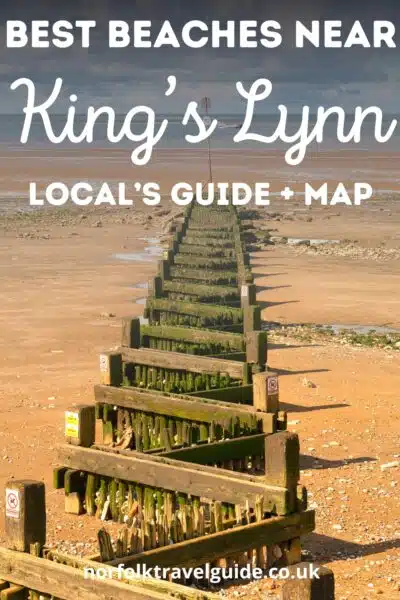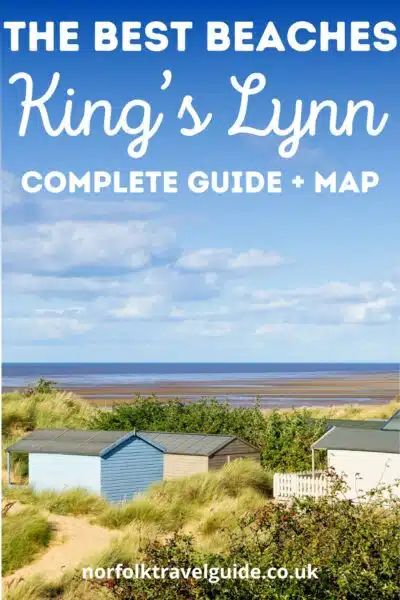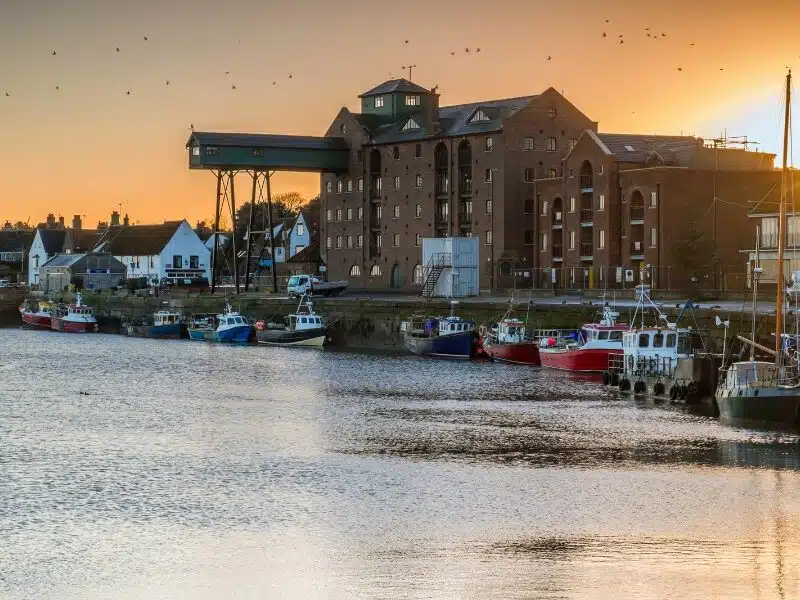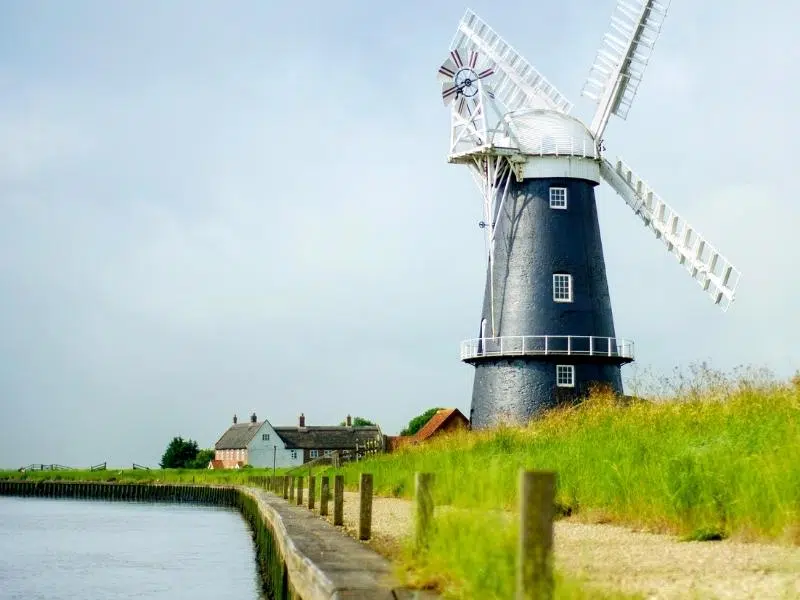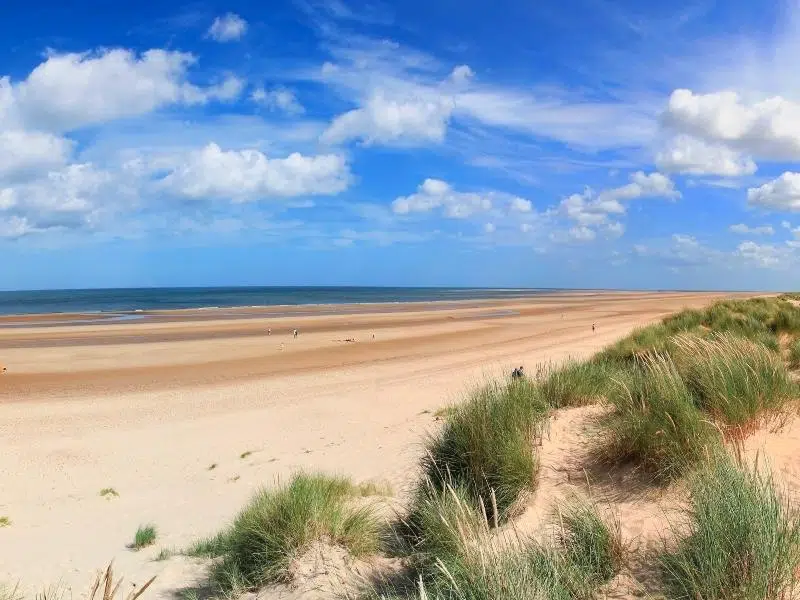Located on the River Great Ouse, King’s Lynn is a mere 4 miles from the mud flats and inner tidal banks of the Wash, a broad multiple estuary where Norfolk meets Lincolnshire and both border the North Sea.
King’s Lynn is a beautiful medieval town with bags of history, medieval architecture and plenty to see and do, but there is no King’s Lynn Beach. However, there are plenty of incredible beaches within a few miles of King’s Lynn if you’re craving a day of sea and sand.
In my guide, I’ll share with you all the best beaches within easy reach of King’s Lynn plus information about parking and facilities, and lots of top tips for an amazing beach day.
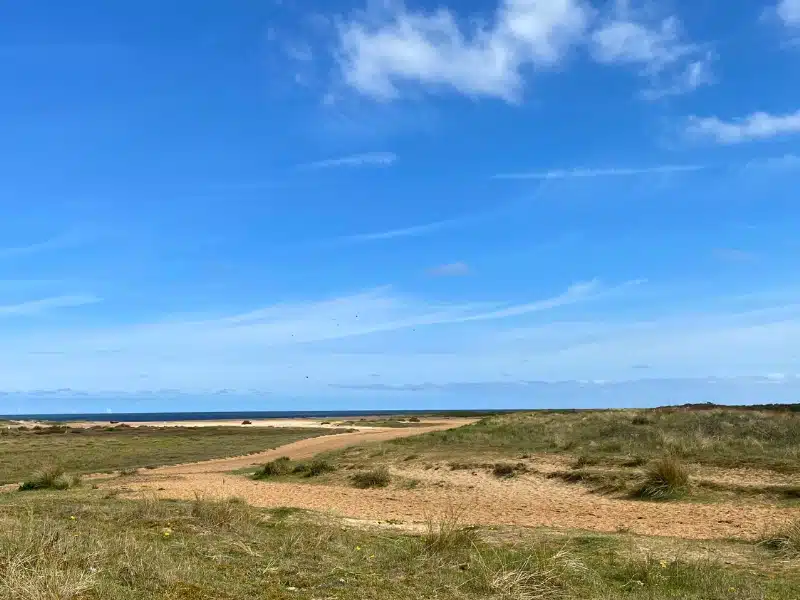
This post may contain affiliate links. If you book something I recommend, I make a small commission without affecting the price you pay!
Quick Guide to the Best King’s Lynn Beaches
- The closest beach to King’s Lynn is Snettisham Beach.
- The best sandy beach near King’s Lynn is Old Hunstanton Beach.
- The best beach for families and kids near King’s Lynn is Hunstanton North Beach.
- The best beach for peaceful nature near King’s Lynn is Holme-next-the-Sea Beach.
- The best beach with no dog restrictions is Old Hunstanton Beach.
Does King’s Lynn Have a Beach?
No, sadly not. The nearest sea to King’s Lynn is that of the Wash, where you would encounter deep estuarial mud flats and not much sand!
RELATED POST: Norfolk Beaches – Ultimate A-Z Guide

Best Beaches Near King’s Lynn Norfolk?
Snettisham Beach
Distance from King’s Lynn: 14.3 miles
Parking: Snettisham Beach car park is right by the beach, making access very easy.
Facilities: There is a nearby pub and a fish and chip shop, but no public toilets – the nearest are at Hunstanton South Beach.
Dogs: Dogs are allowed on Snettisham Beach but must be on a lead during the nesting season from 1st April to 30th August. This is to keep the birds that nest on the shingle and sand, and their eggs and young, safe from harm.
The Beach: Snettisham Beach is the nearest beach to King’s Lynn and one of Norfolk’s three west-facing beaches, perfect for watching the sunset. The shingle beach is vast, making it a great place for long walks, beach games and wildlife watching.
The beach backs onto the Snettisham Coastal Park, a wild area full of heathland, marshland and reed beds that stretch all the way to Heacham, making a great route for a peaceful and easy walk.
The coastal park is adjacent to the RSPB Snettisham Reserve which hosts the incredible ‘whirling wader spectacle’, when tens of thousands of wading birds take flight when the conditions are right.
During an incoming tide, huge flocks of knot, dunlin and oystercatchers are pushed closer to the beach and take to the air en masse as the water covers the mudflats. The best time to see the spectacle is late autumn and early spring during the highest of the high tides.
Snettisham Beach is not really a bucket and spade destination, because when the tide goes out, it leaves mudflats rather than sand, which makes for very messy sandcastles, but this is the best beach near King’s Lynnn for long walks surrounded by nature.
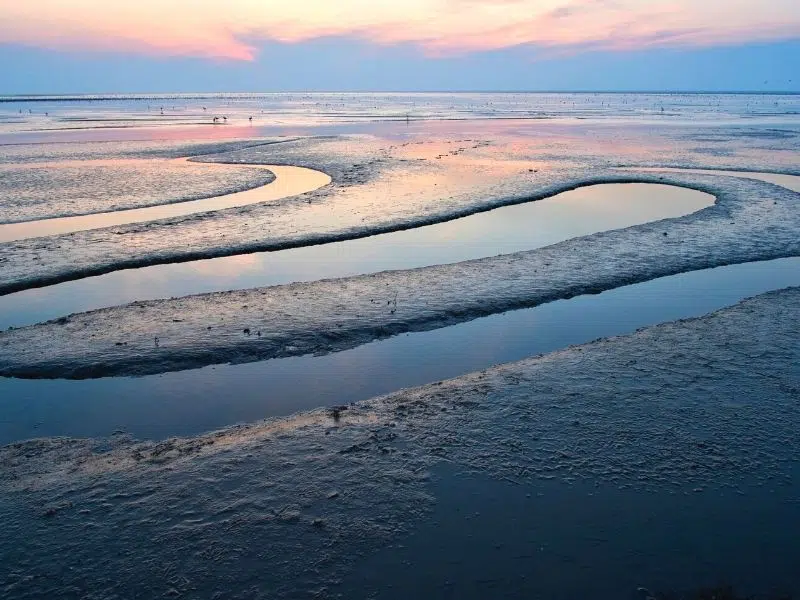
Heacham South Beach
Distance from King’s Lynn: 15.4 miles
Parking: The Ken Hill South Beach Car Park offers at least 100 places in a field a one minute walk from the South Beach. There is a pay and display machine, which takes cash or you can pay using the Just Park app. Be aware that there is a 2.13m height restriction and that the car park will be muddy after any significant rain.
Literally next door is the Heacham South Beach Car Park, run by the Borough Council of King’s Lynn & West Norfolk. There are 20 spaces and 2 disabled spaces on hardstanding and it fills quickly in the summer. There is a pay and display machine which only takes cash, but no height barrier.
Facilities: There is a café next to the car park, together with ice cream stands and kiosks, a beach shop and a seafood shack which sells the local catch including cockles, mussels and whelks. There are public toilets at the entrance to the car park.
Dogs: South Beach Heacham allows dogs but they must be kept on a lead during the nesting season from the 1st April to the 30th August, to protect birds that nest directly on the shingle and sand.
The Beach: South Beach Heacham allows dogs but they must be kept on a lead during the nesting season from the 1st April to the 30th August, to protect birds that nest directly on the shingle and sand.
Close to the Parkdean Holiday resort, Heacham South Beach, known locally as ‘Stubborn Sands’ is quite rugged and good for long walks with the dog, sea fishing and romantic strolls to watch the sun go down.
This is not a lifeguarded beach, but the beach does shelve gently and is suitable for swimming. The water can appear murky at times, which is due to tidal movement stirring up sediment.
There are bands of sand to be found but the South Beach at Heacham is predominantly shingle. Unfortunately, when the tide is out, the beach becomes quite muddy.
RELATED POST: Heacham: Beaches & Family Fun in West Norfolk
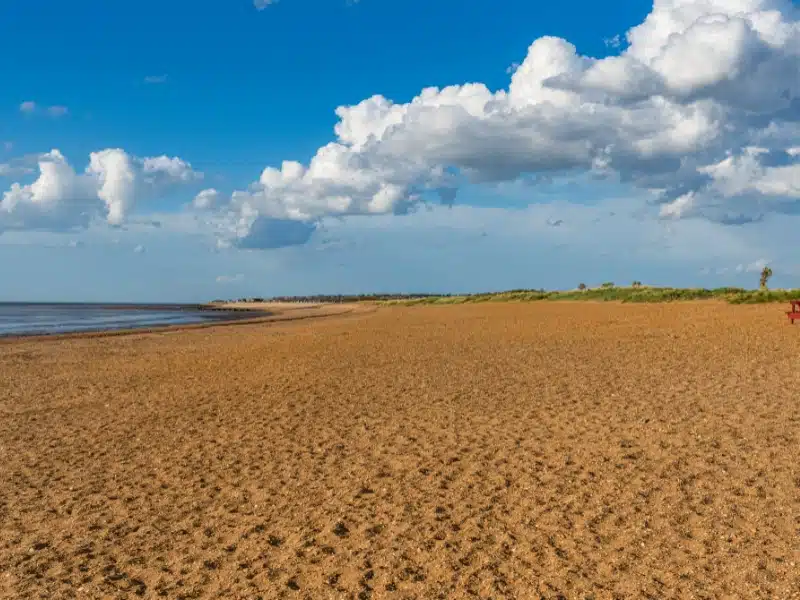
North Beach Heacham
Distance from King’s Lynn: 15.9 miles
Parking: The Heacham North Beach Car Park is operated by the local council and offers 80 spaces and 4 disabled spaces. There is a 2-metre height restriction, and payment is cash only.
If you are visiting West Norfolk on holiday, you can save money by purchasing a Rover car parking ticket. These tickets are valid on all council-run Heacham and Hunstanton car parks and all long-term car parks in King’s Lynn. Rover tickets cost £27 for a seven day period and can be purchased online.
Facilities: At the south end of the car park is Silver Sands, a family-run pub which also offers takeaways, the North Beach Fish Bar and Sunset Grill. Further south by the roundabout are public toilets.
Dogs: There are no dog restrictions on North Beach Heacham, meaning your furry friend can run around and splash in the water all day long.
The Beach: Heacham North Beach has easy access to the promenade, which runs all the way to Hunstanton, and holiday cottages beyond. Jet skis are allowed to operate from here and the beach is usually busy with families in summer, although there is no lifeguard.
The prom is stepped down to the beach, making a perfect place to perch with an ice cream and admire the sea view, without getting your feet in the shingle.
Just behind the beach are a row of colourful privately owned beach huts and on Jubilee Road you’ll find family amusements.
RELATED POST: Beach Huts in Norfolk – All You Need to Know
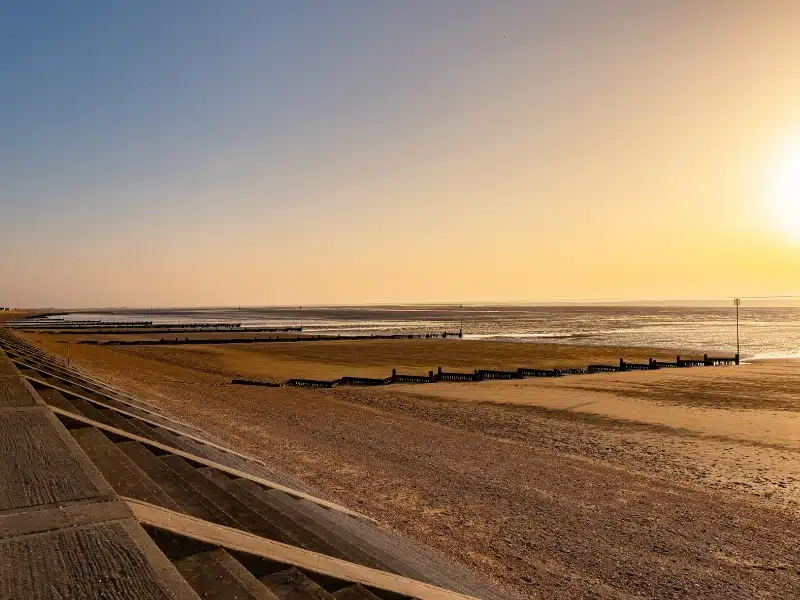
Hunstanton South Beach
Distance from King’s Lynn: 15.9 miles
Parking: Hunstanton Seagate (east) Car Park is the closest to South Beach, about a ten minute walk from the beach. There is a pay and display machine which accepts cash and payments through the MiPermit app. This car park has a 2m height barrier.
Facilities: There are plenty of of places to eat and grab a coffee along the South Promenade and there are public toilets on Seagate Road, along the route from the car park to the beach.
Dogs: Dogs are not allowed on Hunstanton South Beach during the summer months.
The Beach: Located at the southern end of Hunstanton Beach promenade, where it meets Heacham North Beach, lies South Beach, a more peaceful and quiet area of the promenade.
The division between Hunstanton North Beach, often referred to as the main beach, and South Beach is marked by a large slipway, which is used for launching powerboats and other personal watercraft.
Hunstanton Ski Club can be found above the café next to the boat ramp, and Searle’s Sea Tours, which offers seal safaris and coastal trips aboard their amphibious Wash Monsters, launch from the same point.
The promenade features long rows of concrete steps leading down to the sand and shingle beach, which disappears entirely at high tide.
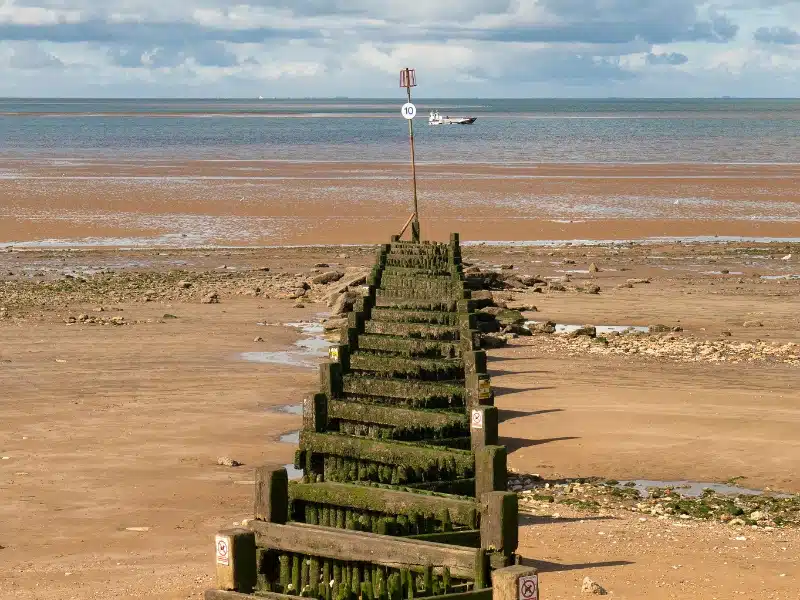
Hunstanton North Beach
Distance from King’s Lynn: 16 miles
Parking: Hunstanton Southend Car Park is located very close to the beach and front. There is a pay and display machine which accepts cash and payments through the MiPermit app. This car park has a 2.25m height barrier.
Facilities: Close to the town, there are plenty of places to eat and drink, as well as amusements, the Alive Oasis Centre, Rainbow Park and traditional beach activities.
Dogs: Dogs are not allowed on Hunstanton North Beach during the summer months.
The Beach: Often referred to as the main beach or central beach, Hunstanton North Beach is a traditional family destination, where sandcastle building, beach games and paddling in the sea are the order of the day!
The promenade is home to Hunstanton Sea Life Sanctuary and Aquarium, with its famous seal hospital, a mini-train to take visitors along the seafront. The Norfolk Coast Path also starts its long route at the end of the North Promenade near the Esplanade Gardens.
As the beach extends north its red chalk, white chalk and carrstone striped cliff face becomes visible. This part of the beach is best for rock pooling, fossil hunting and dog walking outside of summer.
Hunstanton operates a beach patrol service on the town’s main beach from early April to the end of September but there is not an active team of lifeguards on duty.
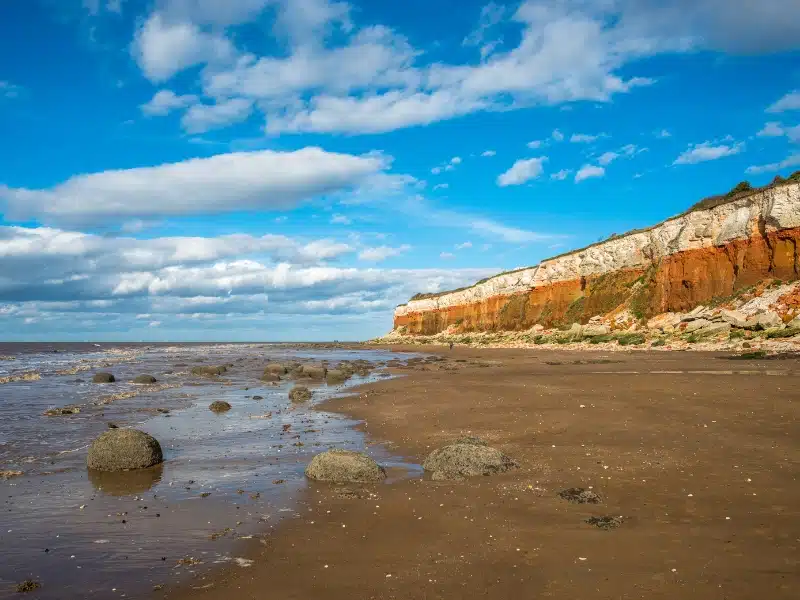
You might also enjoy…
Old Hunstanton Beach
Distance from King’s Lynn: 16.8 miles
Parking: The Clifftop Car Park is a large car park with gently sloping access to the beach. There is a pay and display machine which accepts cash and payments through the MiPermit app. This car park has a 2m height barrier.
Facilities: There is a café and public toilets at the entrance to the car park.
Dogs: There are no restrictions for dogs at Old Hunstanton Beach.
The Beach: Old Hunstanton Beach merges from Hunstanton North Beach, somewhere around where the large cliffs end and the land slopes down to meet the sand dunes which back the beach. If you’re looking for sandy beaches near Kings Lynn, this has to be your first stop!
Old Hunstanton Beach is considered the best kitesurfing beach in the UK and is also an awesome body-boarding beach. Do check the tides here though, visitors can be caught out.
There is also a collection of photogenic beach huts nested in the dunes, where the beach backs onto the Norfolk Coast Path and Hunstanton Golf Club course.
You can also explore the rusty steel shipwreck of the ST Sheraton steam trawler that is visible below Old Hunstanton Lighthouse and wedged in the sand at Saint Edmund’s Point, where the beach widens.
Originally used as a fishing vessel, the Sheraton was requisitioned in both 1914 and 1940 by the Royal Navy and was used as an armed patrol vessel to serve along the North Sea coast.
After the war, the Sheraton was painted a vivid yellow and used as a target ship. It remained anchored in the Wash off Brest Sand until high winds caused it to break from its moorings in 1947 before it eventually settled where it is today.
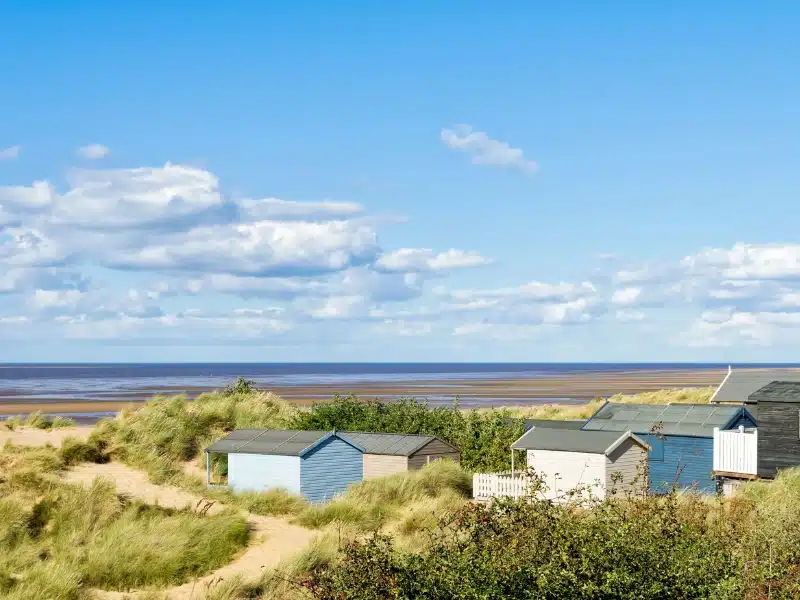
Holme-next-the-Sea Beach
Distance from King’s Lynn: 19.9 miles
Parking: The pay and display car park on Beach Road at Holme is easily accessible. You can pay with cash at the machine or you can use the Phone and Pay app.
You do need to walk through the golf course and dunes to get to the beach, so look out for flying golf balls! The walk takes around ten minutes over compacted paths and soft sand – make sure to take everything you need with you.
If this car park is full, take the right turn just before it onto Broadwater Road. About half a mile along on the right side is another small (and free) car park, just over the track from the Norfolk Coast Path. You can walk back along the path of Beach Road and access the beach.
Facilities: There are public toilets opposite the entrance to the car park, and in summer there is a refreshments kiosk selling ice creams and lollies, hot and cold drinks, and dog treats!
Dogs: Holme is a popular dog-walking beach, with no restrictions. Some of the dunes to the east are part of the Holme Dunes National Nature Reserve and dogs must be kept under control, or on a short lead, and away from cordoned-off areas in order to protect nesting birds and wildlife.
The Beach: Located in the Norfolk coast’s area of outstanding natural beauty, Holme Beach is a real treat. With vast expanses of sand, and grassy dunes in which to take shelter, play hide and seek or enjoy a picnic, it’s easy to spend a day here, often without seeing another soul!
I loved coming here as a kid and spent hours running up and down the sands collecting water for my sandcastle moat, playing beach cricket, and learning to fly a kite when the wind. The small sandy pools where water gets trapped as the tide retreats are also great for smaller kids to play in.
Smaller children will benefit from beach shoes or jelly sandals as some of the shingle can be sharp, but this usually forms in a single high tide line and once you’ve hopped your way over the pebbles, the sand is lovely and soft.
There is a gentle slope into the water and the waves are usually small. However, this beach is not lifeguarded so children will need supervising in the water, as there is always a chance of rip tides and unexpected currents. It is also advised by HM Coastguard not to use lilos or inflatables at this beach.
In 1998, an early Bronze Age timber circle was discovered on the sands of Holme Beach. An extraordinary find, the arrangement of 55 timber posts surrounding a huge stump that had been buried with its roots upwards was called Seahenge, as it resembled the famous Stonehenge in Wiltshire.
When Seahenge was created around 2050 BCE, the area around Holme was a salt marsh. Over thousands of years, the marshes were covered in peat beds as the sea encroached, and the peat preserved the timbers, keeping them whole.
The timbers were carefully removed from the sea, cleaned, and vacuum freeze-dried to protect them. The original upturned tree stump and many of the upright timber posts are now on display in a special exhibit in the Lynn Museum in nearby King’s Lynn.
Along with the Deep History Coast, located between Weybourne and Cart Gap along the clifftops of the North Norfolk coast, Seahenge adds to the fascinating rich tapestry of Norfolk’s ancient history.
RELATED POST: Holme Beach – Complete Visitor Guide
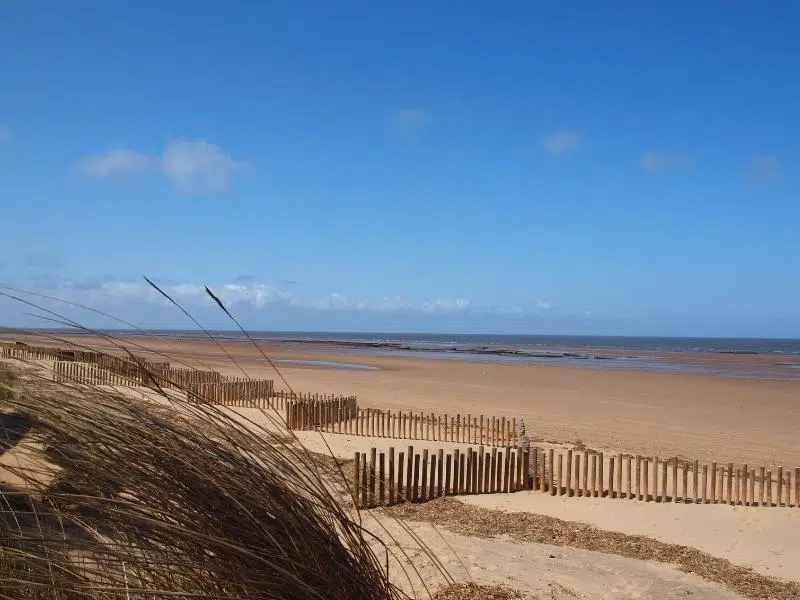
Brancaster Beach
Distance from King’s Lynn: 21.3 miles
Parking: The Brancaster Beach parking lot at the end of Beach Road is owned by the Royal West Norfolk Golf Club. There is a pay and display machine which takes cash, contactless and cards, and you can also use the Flowbird app.
The car park is not very well maintained and there are lots of large pot-holes to avoid! In winter or when the weather is wet, the car park gets really muddy.
The road to Brancaster Beach car park can flood at high tide, and the water is usually too deep for cars to pass. Use the RWNGC website to check for the best time to visit, and plan to arrive before high tide and leave at low tide, meaning you get the whole day on the beach.
Facilities:
There is a toilet block opposite the car park, and a beach kiosk (open from March to November) which sells beach toys, hot and cold drinks, ice creams and snacks.
Dogs: Brancaster is very dog friendly, and the National Trust, who manage the beach, say it’s a two-pawprint-rated place. This means there are water bowls and dog bins available at the entrance to the beach.
Between May and September, there is a fenced-off dog-free zone at the eastern end of the beach (to the left of the entrance) where the beach meets RSPB Titchwell Marsh Nature Reserve. This restriction is to protect nesting birds.
Otherwise, the whole expanse of the beach is available for dogs to run around, splash in the sea and meet other four-legged friends.
The Beach: Brancaster Beach, known locally as ‘Branny’ is a quick walk from the car park making it easily accessible, especially if you got loads of kids and beach paraphernalia with you.
The beach shelf is very shallow and hundreds of meters of sand are exposed when the tide goes out. This perfect sandcastle-building sand, which is firm enough for even the most active of beach games, makes Brancaster a top spot for families.
The natural and unspoiled dunes provide shelter and privacy and make a useful windbreak! It’s one of my favourite spots to picnic in Norfolk, before spending a lazy afternoon with a good book or sunbathing.
Swimming in the sea is safe, but there is no lifeguard at Brancaster Beach, so children should only swim with adults supervising, and the use of inflatables is not advised.
The tide at Brancaster comes in quickly, filling the low points between sandbanks and cutting them off from the land. Please read the warning notices at the beach and be aware of Brancaster Beach tide times when visiting.
Every year, the RNLI from Hunstanton and Wells rescue unwary beachgoers who get stranded as the tide comes in and fills the hidden channels with a strong current, which can easily sweep people out to sea.
One of the reasons I love Brancaster Beach is that in summer you can spot small groups of seals in the water as they swim west along the coast from Blakeney in search of food. You’re unlikely to see a seal on the beach though, as they tend not to come ashore where there is no established colony or breeding ground.
If you’re swimming at Brancaster, you may be lucky enough to have find a curious seal popping up to check you out – don’t worry they won’t harm you.
RELATED POST: Brancaster Beach – Complete Visitor Guide
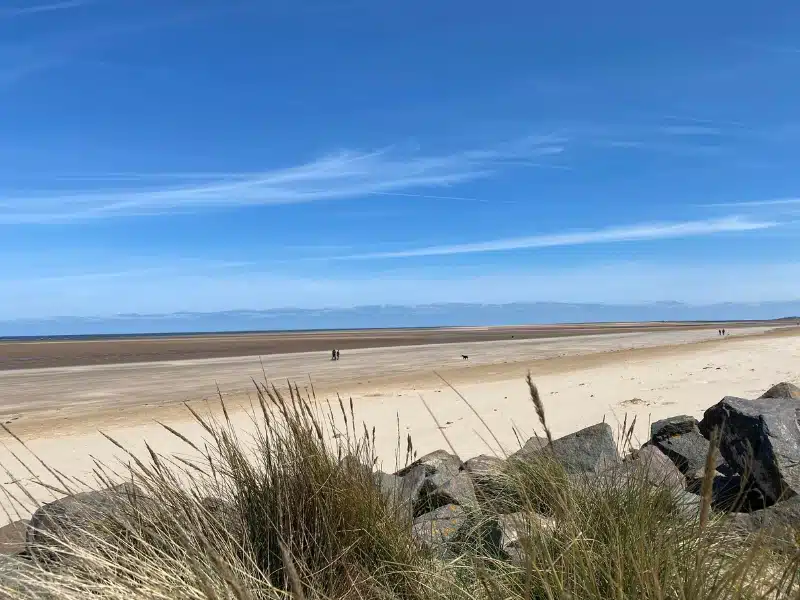
Map of King’s Lynn Beaches
How to use this map – Use your fingers (or computer mouse) to zoom in and out. Click or touch the icons to get more info about a place, and click the arrow in the box top left to open the index. To add to your own Google Maps account, click the star next to the title of the map.
Have you visited any of these King’s Lynn beaches? Which is your favourite? Leave a comment below!
Love it? Pin It!
